For the fourth year, the Center Camp Café was located within the same structure, and nearly all of our volunteers were veterans, which allowed us to successfully plan and execute the most ambitious café yet.
ART, DÉCOR, AND LIGHTING
In 2003, we continued to be Burning Man’s largest theme camp, taking the art, décor and lighting “Beyond Belief.”
Theme-related ideas abounded at décor team meetings, and at our five volunteer craft parties before the event and even more so on-playa; we saw more volunteers than ever before fully participating in all stages of turning the café into a temple of art, performance, and nighttime spectacle. Much of the elaborately painted furniture and props were designed with the four elements of C.A.F.É. in mind: coffee, air, fire, and earth.
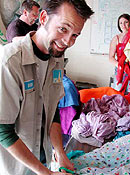 We were lucky to have more highly skilled year-round volunteers and were pleased to discover several “décor genies” in the on-playa volunteer crew. This provided a level of expertise in key areas: construction, sewing, and furniture packing. The setup volunteer effort also clearly benefited from the pre-event gate closure and the enforcement of the early arrival list. Volunteers who arrived early checked in and were committed, enthusiastic, and ready to work. New volunteers who came for one day of setup returned day after day Veteran café volunteers acted as team leaders, especially in painting, and projects were better coordinated, enabling multiple teams to work concurrently with volunteers assigned to tasks immediately. Our very active volunteer coordinator skillfully motivated our volunteers, and we were able to meet every pre-playa goal, arriving on-playa well prepared. The volunteer coordinator worked tirelessly on-playa during setup and takedown, keeping volunteers motivated and managing the inventory system. For the first time, we know what we have in storage and where its located!
We were lucky to have more highly skilled year-round volunteers and were pleased to discover several “décor genies” in the on-playa volunteer crew. This provided a level of expertise in key areas: construction, sewing, and furniture packing. The setup volunteer effort also clearly benefited from the pre-event gate closure and the enforcement of the early arrival list. Volunteers who arrived early checked in and were committed, enthusiastic, and ready to work. New volunteers who came for one day of setup returned day after day Veteran café volunteers acted as team leaders, especially in painting, and projects were better coordinated, enabling multiple teams to work concurrently with volunteers assigned to tasks immediately. Our very active volunteer coordinator skillfully motivated our volunteers, and we were able to meet every pre-playa goal, arriving on-playa well prepared. The volunteer coordinator worked tirelessly on-playa during setup and takedown, keeping volunteers motivated and managing the inventory system. For the first time, we know what we have in storage and where its located!
Café art installations went sky-high in 2003 with Radiant Atmospheres’ “The Illuminomicon” in the center of the café, which cast signature beams of light skyward over the shimmering metallic flags and sent colored patterns like stained glass dancing across the café’s ceiling. More beams at the Front Portal cast eerie silhouettes against Michael Christian’s playful metal figures atop his massive Portal. Ezra Eismont’s “Jewels in The Net of Indra” stretched close to 200 feet across our back fence, connecting large paintings based on sacred geometries.
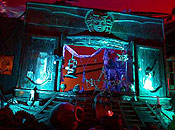 There were also 12 altars at the edges of the café structure each with inspirational objects ranging from ironing boards to zip-ties, which were created by artists from across the United States, and a large labyrinth, which covered the floor of the center circle. “The Passage” by altar artist Minx was a walk-through experience of the four elements, and nearby, a waterfall sent up a fine mist, refreshing participants. The only shortcoming was the need for better representation of the art in the What Where When guide.
There were also 12 altars at the edges of the café structure each with inspirational objects ranging from ironing boards to zip-ties, which were created by artists from across the United States, and a large labyrinth, which covered the floor of the center circle. “The Passage” by altar artist Minx was a walk-through experience of the four elements, and nearby, a waterfall sent up a fine mist, refreshing participants. The only shortcoming was the need for better representation of the art in the What Where When guide.
So often on-playa, we say there isn’t enough time, but in 2003, we were on or nearly on time with the completion of everything we had planned to do. The best example of this was that the takedown was finished in 2.5 days—a personal best! The decision to begin removing décor on Monday, while event participants were still around and eager to lend a hand, made a huge difference. The only problem was that we had to wait for trash in storage trailers to be emptied and also for one trailer to be moved to the café site before volunteers could load decor and keep our process moving.
Café Artists
The number of returning artists was quite significant and yet, because of the expansion of usable space, there was a strong representation of new artists’ installations. Because there were a number of veteran artists, the Café Art, Décor and Lighting staff was able to focus on helping newcomers adjust. Improved radio communications helped improve artist coordination of installation arrivals and transportation. Throughout the event week, artists were available to answer questions about their installations, and people were able to see the work in progress, giving a new interactive experience to the art!
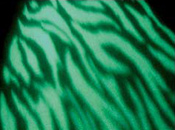 The center lighting installation artists created a visual spectacle visible from the perimeter of the city, making the café easy to locate at night. As the event week progressed, the brightness and intensity of the light show grew. There were some problems with communication between the lighting artist team and the café team during setup, testing, and on opening night. In the future, a more detailed plan should be followed with the lighting artists and the café team throughout the event (pre-playa, setup, event week, and takedown).
The center lighting installation artists created a visual spectacle visible from the perimeter of the city, making the café easy to locate at night. As the event week progressed, the brightness and intensity of the light show grew. There were some problems with communication between the lighting artist team and the café team during setup, testing, and on opening night. In the future, a more detailed plan should be followed with the lighting artists and the café team throughout the event (pre-playa, setup, event week, and takedown).
One lesson learned this year was that, overall, the café artists needed more support. Installing art at the back fence is a huge task and not enough attention and appreciation was given to those artists. There is also a need for more consistent pre-playa communication between the artist liaison and all café artists as well a more detailed plan for large-scale installations.
Furniture
Filling the café with tables, chairs, and benches is a huge task. This year the carpentry team on-site was more than accommodating. We had a good number of skilled carpenters, and our returning ‘head’ carpenter stepped up whenever asked, demonstrating invaluable teamwork.
When a load of benches arrived in separate pieces the weekend before opening day and assembly was given to the team, they took it on and quickly assembled and painted all of the pieces. Thankfully, there were enough carpentry tools and skilled help to get everything completed.
 The carpentry volunteers were amazing. An assembly line was formed where each bench was built, then primed, then base-painted, and then painted with artwork by one or two people. The result was a family of benches covered in detailed artwork and personal touches and very proud artists. This was such a success that most of these benches will not need to repaint next year as the detail lasted even through the dust storms!
The carpentry volunteers were amazing. An assembly line was formed where each bench was built, then primed, then base-painted, and then painted with artwork by one or two people. The result was a family of benches covered in detailed artwork and personal touches and very proud artists. This was such a success that most of these benches will not need to repaint next year as the detail lasted even through the dust storms!
Bike Racks
One of the biggest obstacles for the café during event week was the absence of bike racks outside the café. Nearly all the previous year’s racks disappeared. Unfortunately, there was not enough time or resources to replace them. There also may have been more bikes this year due to the city’s population increase. Because of the lack of racks, many bikes were brought into the café in areas where art altar installations were, disrupting the art installation and taking up valuable space. Efforts to produce bike racks will begin in early 2004.
Final Night of Setup
An ongoing issue during set up was the number of people walking through the café before it was completed. Up until opening, there was still a lot of construction going on that could have proven harmful as well as unsecured tools and other equipment that could have caused injury or been stolen. This year, we placed caution tape around the perimeter of the café to limit the number of casual participants wandering through what was still a dangerous construction zone.
Radio
The increase in the number of radios available to our staff resulted in better communication throughout the setup, during the event and after the-event. It was especially helpful with pre-event week gate communications. Also, the radios enabled the café artist liaison to coordinate with Media Mecca for tours of the café.
Pre-playa Café Team
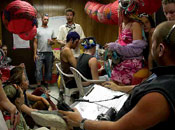 The establishment of the Extranet was a key part to this year’s successful communications between team members located around the world. E-mail, digital photo, and PDF file sharing as well as consistent meetings and electronically distributed meeting minutes also improved the year-round planning. All café team members improved e-mail relations with volunteers. As a result there were better turnouts at the art and décor craft parties in San Francisco; improved coordination with artists in placement and resource needs; more veteran volunteers throughout the whole café; and greater productivity pre-playa and on-site.
The establishment of the Extranet was a key part to this year’s successful communications between team members located around the world. E-mail, digital photo, and PDF file sharing as well as consistent meetings and electronically distributed meeting minutes also improved the year-round planning. All café team members improved e-mail relations with volunteers. As a result there were better turnouts at the art and décor craft parties in San Francisco; improved coordination with artists in placement and resource needs; more veteran volunteers throughout the whole café; and greater productivity pre-playa and on-site.
Sub-teams within the café teams streamlined operations, resource allocation, and needs identification. Regrouping into sub-team enabled the volunteer resources to be utilized more efficiently.
COFFEE SHOP
As was the case with other sub-teams, the Coffee Shop had a strong returning team of operations folks, shift managers, the Muddy Waters ringers handling equipment and backstage details, and—as always—our rock star baristas and runners.
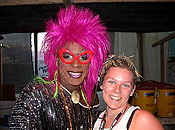 Volunteer recruitment for the Coffee Shop ramped up in January and was steady throughout the spring and summer, resulting in approximately 800 volunteers scheduled for shifts during the event. Our Café Community online newsletter, the Liquid Voice, kept volunteers up to date with important news and information. On-playa, we set up a volunteer welcome desk next to the coffee counters, which provided information, orientation, and allowed participants to walk up and volunteer to fill open slots. This welcome desk was a fabulous success, and we intend to maintain and expand its function in 2004.
Volunteer recruitment for the Coffee Shop ramped up in January and was steady throughout the spring and summer, resulting in approximately 800 volunteers scheduled for shifts during the event. Our Café Community online newsletter, the Liquid Voice, kept volunteers up to date with important news and information. On-playa, we set up a volunteer welcome desk next to the coffee counters, which provided information, orientation, and allowed participants to walk up and volunteer to fill open slots. This welcome desk was a fabulous success, and we intend to maintain and expand its function in 2004.
Another innovation in 2003 was the institution of shift co-managers. This change happened somewhat accidentally this year as we were forced to fill two historically busy shifts with new people and found two pairs of friends who were delighted to have the chance to work and learn together. In fact, we saw that having two managers available allowed operations to run much more smoothly—given that there is 150 feet of counter space and often as many as 50 volunteers on shift at any one time—and so we plan to continue this model in 2004.
Another change this year was adding a formal café beautification role to our event-week team. This person took charge of the trash bins in the café—cleaning up after participants who imagined that it was appropriate for them to leave their trash scattered behind them—and general café recycling and logistical details. By having someone focused on these tasks, we received valuable feedback about the tools and resources needed to do this job well and safely, and we’re looking forward to better planning for this important role in 2004.
CAFÉ PERFORMANCE
In 2003, the Café Performance Team, which worked closely with Café Sound and Café Spoken Word, worked hard to put together performance spaces, equipment, and performance schedules. We built staging and housing for the equipment using resources and ideas from previous years as well as constructing new parts, some of which can be reused in 2004. The major components for successfully running the Music and Spoken Word stages were once again in place on opening day, ready for performances.
The team rigged sound systems for the Café Coffee crew behind the counters and provided equipment for the commissary to use for any entertainment there. We also provided sound in several shade structures in Café Village, but this was a personal contribution to the camp and not part of the “job.” During the week, we had an eclectic mix of performers booked and open slots to allow for on-the-playa walk-up participation. Not all of the performance slots were realized to their fullest potential, but overall there were amazing performances on both stages.
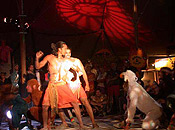 Another aspect of Café Performance that we determined should be better utilized in the future was the “Center of the Center” and other performance spaces in and around the café. Coordination with performers regarding these auxiliary spaces will be high on our list of priorities in the upcoming year. These spaces offer amazing opportunities for highlighting the arts, and they deserve the attention of the resources the existing performance spaces offer.
Another aspect of Café Performance that we determined should be better utilized in the future was the “Center of the Center” and other performance spaces in and around the café. Coordination with performers regarding these auxiliary spaces will be high on our list of priorities in the upcoming year. These spaces offer amazing opportunities for highlighting the arts, and they deserve the attention of the resources the existing performance spaces offer.
Because of years of “penny wise and pound foolish” decisions to work with used and donated equipment with which we “made do” in this challenging environment, our biggest problems in 2003 were equipment failures and the lack of adequate backup resources that would have allowed us to recover from our losses. These problems resulted in the loss of prime performance time and crippled our operations. The decision to purchase and maintain professional equipment for on-playa and year-round use is a sound one. This, combined with a renewed energy and improved process, puts Café Performance in a great position to approach the 2004 event.
CAFÉ DOCUMENTATION
A team of volunteer photographers and videographers came together to document the year-round and on-playa planning and production of the café. Their contributions will be featured in our annual Documentation Project. The URL for the project will be listed here as soon as the project is completed.
Overall, we all agree that this was the best café ever, with more beautiful art; better planning, execution and clean up; and a less stressful period of planning and execution. Thanks to all who helped make it happen and to all who enjoyed our space and told us how much they appreciated our work!
Compiled and completed by,
Dana Harrison from submissions by
Marcia Crosby, Bonnie Schneider, Marie Gerrard, Tom Kapanka
and Heather Gallagher

